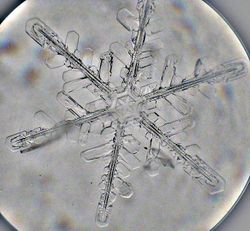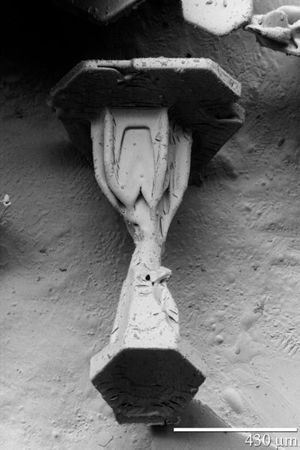Snowflake
Many people know that no snowflake is the same, but only a few people truly known why this is so. The snowflake is a dynamic structure made by ice crystals that form on a nucleus. This ice crystal could have formed from a nucleus of pollution, dirt, dust or other small particles. All snowflakes have the hexagonal prism from which they begin. They sprout ice branches in their own unique way. Only by the use of a microscope can the human eye see the true patterns and symmetry of the complex snowflake. The snowflake is also a symbol of the christian holiday of Christmas, and of the washed away sins by Christ. The snowflake is the symbol of peace, serenity, and a sense of calmness. It can be one of the most soothing experiences. Watching a snowflake travel to the ground or land on your tongue will always be a symbol of great happiness. Meteorologist know much more today than they did in the past 10 years, on how to record and predict the future weather. There are many details on why a snowflake forms and looks the way it does.
Formation
The formation of snowflakes is a complex and slightly theoretical process. The forming of the snowflake all starts out inside of a cloud. The cloud holds water vapor which is the beginning of the snowflake. 32° F (0° C) is the freezing point of water, which is when the snowflake is becoming a solid. Many natural changes can happen when a snowflake is forming because of the elements that can affect the physical and inner details of the flake. Pollution, dirt and dust are just three of the elements that can affect the snowflakes weight, durability and characteristics of the ice crystals. For instance, colder weather produces more sharply pointed shapes and arms. Warmer weather conditions create less intricate and detailed characteristics, because they take longer to form. [1] The tiny crystal that forms around the first particle is often known as the "seed" of the snowflake. These ice crystals are known as minerals because they form naturally from a chemically structured composition. Naturally, the heavier the snowflake the faster it falls, and therefore it has less time to progress in its characteristics. Therefore heavier snowflakes usually are less intricate and complex. [2]
The formation of a snowflake is quite an amazing thing. Tiny molecules, attaching to each other. The experience different weather conditions and growing different characteristics. A snowflake begins growing one way and only a moment later it could be growing in a totally different way. [3]
As earlier stated, different temperatures create differently designed snowflake arms. According to About Education[4] the following temperatures result in the following characteristics:
32-25° F - Thin hexagonal plates 25-21° F - Needles 21-14° F - Hollow columns 14-10° F - Sector plates (hexagons with indentations) 10-3° F - Dendrites (lacy hexagonal shapes)
This is clear list that tells us just how the temperature can affect the appearances of a snowflake.
Symmetry
When a snowflake is first forming, is starts out as a nucleation from some sort of particle (dust, dirt, pollution). When combined with a water vapor molecule the water freezes creating an ice crystal. They grow as the exit they cloud and fall through the sky. Smooth sections of a flake grow much slower. This results in a 6 sided hexagonal prism. The corners then begin to have longer growths. Next, as temperature changes the flake begins to grow new shapes at the ends of each corner. Every time a temperature or pollution condition changes so does the design and style of the snowflake. This leads us to conclude that there are symmetrical snowflakes. But they are only symmetrical to themselves, and even these are not common. There is a different pattern for each and every snowflake, making each unique and each amazingly intricate. The most common type is that of completely unorganized or patterned shape. No other snowflake experiences the same exact conditions. Therefore none can be the same. Which is truly an amazing thought, knowing that each snowflake is completely unique. [5]
When a snowflake is forming, there are many tiny molecules attracting each other and coming together to form the snowflakes own unique but specific pattern. Usually when some sort of liquid freezes it freezes at the lowest energy state, which often results in some sort of patterned and organized symmetry. Though this symmetry can seem quite random and unique it still always follows the the hexagonal, six sided, pattern. Different branches, shapes, sizes, and designs are all results of some sort of change in the atmosphere. There are endless possibilities to a snowflakes appearance and weight. [6]
Used as a Symbol
The snowflake is known for begin used as a symbol of the Christmas holiday. Being a Christian holiday, the snowflake symbolization of Christmas is directly connected to the amazing power and creativity of the universe's creator. The fact that he can create each snowflake different from the other is amazing to think of. It reminds us of how uniquely God made each and everyone of us. He kind of created his own analogy of all the people on earth, each unique and each special. It also symbolizes the feeling of peace. When it snows, there is a mysterious peace that is sensed to the people around it, and maybe even to the animals. Related to peace, snow and it's spotless shade of white resembles the character of purity. This is a great connection to God, and is often used to describe how God made our terrible sin into something that is blameless and spotless in his eyes. Just like snow. [7] Snowflakes are often used to symbolize Christmas in a more physical way as well. A commonly known craft of cutting snowflakes is used around the world. You can create these from paper coffee filters, ect. It is a great way to remember the symbols of a true snowflake. [8]
Meteorology
Over the past years science, meteorology has grown so much in their ability to predict the details of snow. Details like: how big will the flakes be? Will the snow stick? How long will it snow? These are all common questions that are much easier to predict nowadays. Meteorologists are able to read the temperature in order to determine/predict the size of the expected snowflakes. [9]
Video
A video on the formation of snowflakes.
References
- ↑ Answers to Common Snowflake Questions About Education. Date Accessed: January 26, 2016. Unknown Author.
- ↑ How Do Snowflakes Form? Geology.com. Web. Date Accessed: January 26, 2016. Unknown Author.
- ↑ We need your help! National Oceanic and Atmospheric Administration. Web. Date Accessed: January 27, 2016. Unknown Author.
- ↑ Answers to Common Snowflake Questions About Education. Accessed: January 27, 2016. Unknown Author.
- ↑ Frequently Asked Questions about Snow Crystals SnowCrystals.com. Accessed: January 26, 2016. Unknown Author.
- ↑ Why are snowflakes symmetrical? How can ice crystallizing on one arm 'know' the shape of the other arms on the flake? Scientific American. Accessed: January 27, 2016. Unknown Author.
- ↑ Religious Topics - Symbolism of the snow traditioninaction. Web. January 26, 2016. (specify whether its the date of publication or last-modified or accessed - i.e. Published November 3, 2015.Unknown Author.
- ↑ - What are Chrismons? Christ Monograms, Jesse Trees Symbols of Faith Christmas Ornaments traditioninaction. Web. January 26, 2016. (specify whether its the date of publication or last-modified or accessed - i.e. Published November 3, 2015.Unknown Author.
- ↑ Why are some snowflakes big and fluffy, and some skinny? mlive. Web. Last Assessed: January 27, 2016. (specify whether its the date of publication or last-modified or accessed - i.e. Published November 3, 2015.Unknown Author.
| ||||||||||||||



